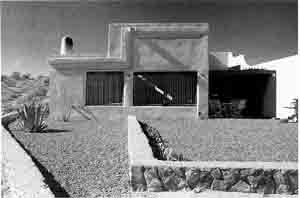Like the igloo, the adobe house is low maintenance only in a specific climate—very dry, in adobe’s case. Adobe, which is sun-dried mud—a mixture of sand, silt, clay, and chopped straw—is really a very soft brick, and it resembles brick in many of its properties. But unlike brick, it will deteriorate in a humid climate. In the dry areas of the Southwest, where it's traditional, adobe is practical, durable, and easy to maintain. There are adobe walls still standing that are over 500 years old, some perhaps even 1,000 years old.
Traditionally, adobe is plastered over with the same clay used to make the adobe bricks. Traditionalists are trying to revive this kind of plastering, but it's not as maintenance-free as using ordinary stucco, especially for an exterior finish. Stucco goes on over adobe as easily as over concrete block, although for exterior walls, metal lath (chicken wire will work) is nailed to the adobe wall first. The scratch coat is then applied, and a second brown coat put over it. Usually a third finishing coat is then applied as in regular stuccoing. On the inside, metal lath is generally not used. A coat of fibered gypsum plaster is troweled on, followed by a second and final coat of unfibered gypsum plaster.
Insulating Value
Contrary to popular opinion, adobe is not a good insulating material, at least in R-value measurements. But like brick and concrete its bulk provides great thermal stability—slow to heat up and cool down. On a hot day, it's cool in an adobe house. If the night grows chilly, as happens in the Southwest, the adobe house radiates the heat absorbed during the day and maintains a comfortable temperature. In cold weather, the walls will absorb the heat of a hot stove and radiate it back after the stove fire goes out. In technical terms, adobe has a very good “dynamic thermal response,” a term I used earlier. To increase its insulative value, you can add polystyrene or polyurethane panels over the adobe and then stucco the panels as previously described. Some builders spray 2 inches of polyurethane foam over the exterior adobe walls and stucco over it after it hardens.
Adobe Bricks

Look closely at the top
center of this modern adobe house and you’ll see an interior gutter s
tern built into it to direct rainwater away from the walls.
Making adobe bricks is easy but making enough for a house is strenuous labor. The best way is to make forms out of 2-by-4 lumber (4-by-10-by-14 inches or 4-by-12-by-14 inches are the usual dimensions for the usual 10- or 12-inch-thick walls). Two-, four-, or six-unit gang molds are the handiest.
There are easy methods to determine if your clay soil will make good adobe, but if you are a beginner, you would be wise to seek advice. Suffice it to say, this is one instance when you don't want organic matter in the soil that keeps it loose and friable. If you live where adobe is practical, advice should not be hard to find, and if you don’t, you probably shouldn’t be making adobe anyway. At any rate, making your own adobe bricks is more practical (but not much) than making your own concrete blocks, because all the ingredients you need are available, cheap, and easy. Stand the hardened bricks on edge to dry in the sun. Curing time is ten days minimum. Store bricks so that rain can't hit them directly, but with the edges open to good air circulation, and stack in such a way that pressure from the weight will not ease them out of shape.
Mortar for adobe bricks is made of the same clay used for making the bricks but the straw is left out.
Keeping It Dry
Water is the great enemy of adobe, which is why an adobe house is built the way it's . We Eastemers never understand why those timbers protrude from the side of an adobe house near the roofline. In a real adobe house, those protruding timbers are hollowed out at the ends to draw off water that gathers on the nearly flat roof. Today not all the timbers are hollowed for drains, or canales, as they are called; usually only the end ones are. The roof is nearly flat so as to expose the least amount of expanse to falling rain, and therefore reduce runoff to the minimum. The walls rise above the roofline to ensure that all the water is funneled through the canales to drip harmlessly out away from the wall, not run down the wall or splash against it.